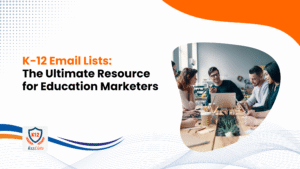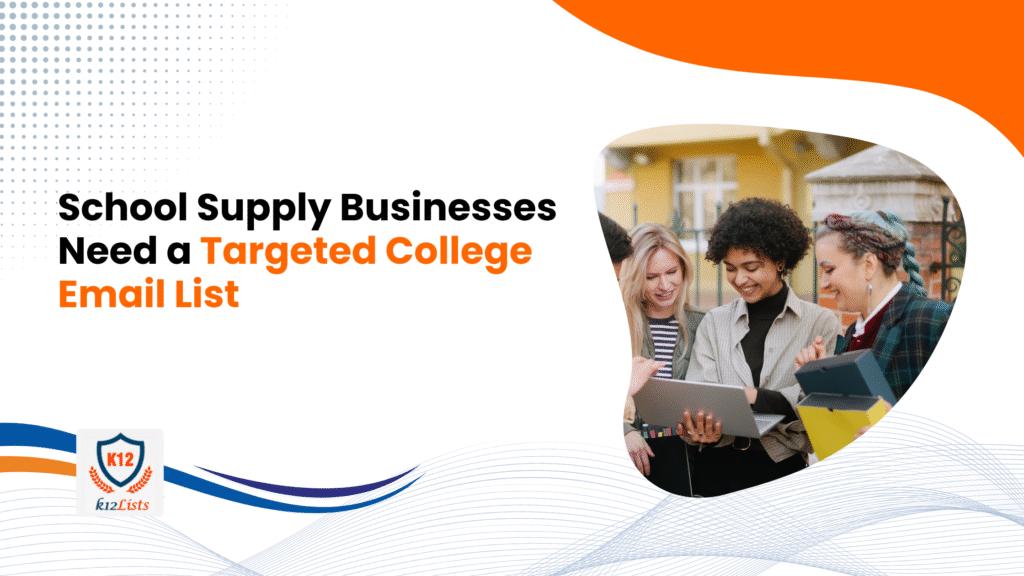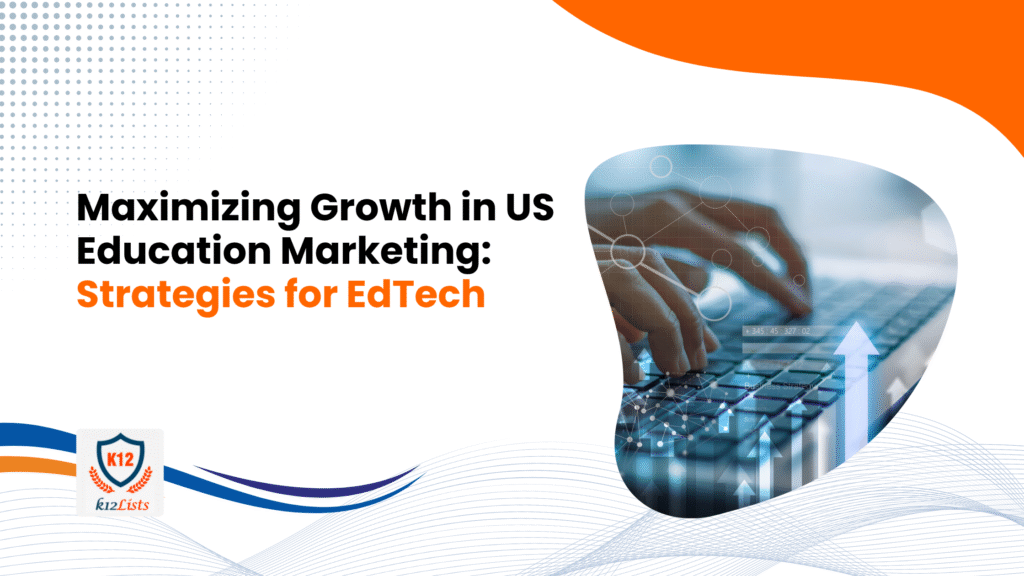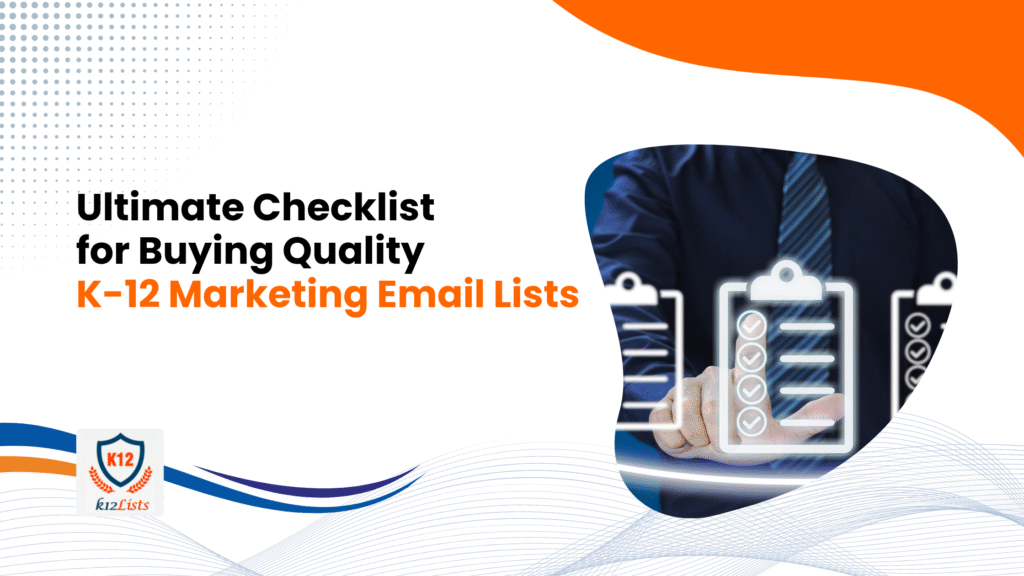Artificial intelligence (AI) transforming K-12 email marketing by delivering highly personalized content, automating repetitive tasks, and continuously optimizing campaigns to boost engagement and effectiveness. By analyzing large volumes of data on school staff preferences and behaviors, AI enables precise targeting and content customization tailored specifically for educators and administrators. This data-driven approach results in significantly higher open and click-through rates, strengthening communication between education service providers and key decision-makers within K-12 schools
Our K-12 Schools Email Database provides direct access to a valuable network of school principals, administrators, and educators. This list is perfect for businesses offering products or services aimed at schools, helping you reach key decision-makers who influence purchasing and policies. It’s an essential tool for making meaningful connections within the K-12 education sector and driving your marketing efforts where they matter most.
To effectively promote products and services that support schools, it’s essential to reach the right audience—principals, administrators, and key decision-makers who control budgets and make purchasing decisions. Using Verified K-12 Email List for AI in email marketing gives you direct access to these influential contacts, allowing you to deliver personalized, targeted messages that resonate and drive meaningful engagement.
What Is a K-12 Email List?
A K-12 email list is a curated collection of verified email addresses belonging to key decision-makers and principals within the K-12 education system. These lists are often segmented by district, role, region, and even school size. The goal? To ensure your message reaches the right people, whether you’re sharing new learning tools, announcing virtual events, or providing important updates. When paired with AI in email marketing, these lists become even more powerful-enabling smarter segmentation, personalization, and higher engagement.
5 Benefits of Artificial Intelligence(AI) in Email Marketing
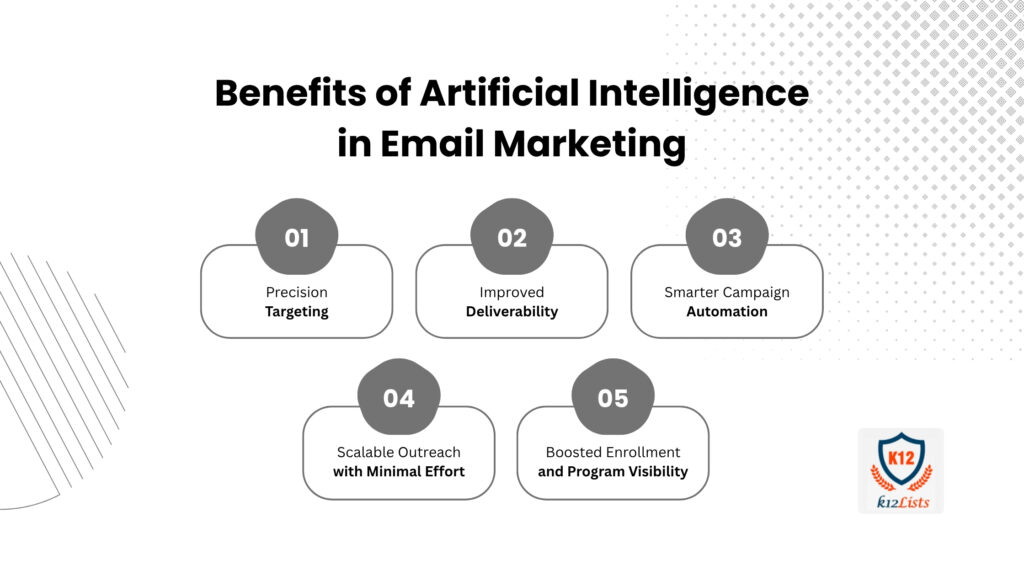
1. Precision Targeting
Reach the right educators, principals, and administrators with segmented data tailored by job title, district, or region-perfect for personalized AI-driven campaigns.
- Verified data lets you focus your message on decision-makers who matter most.
- Segment audiences further by interests, school size, or region.
2. Improved Deliverability
Clean, verified email lists reduce bounce rates, avoid spam filters, and ensure your messages land in the right inboxes every time.
- High-quality lists protect your sender reputation and improve inbox placement.
- Avoid wasted efforts and budget on undeliverable or invalid emails.
3. Smarter Campaign Automation
AI tools thrive on quality data. Verified lists allow for advanced automation, including dynamic content, behavioral triggers, and optimized send times.
- Automated workflows become more effective when powered by real, active contacts.
- Send personalized emails at the exact time your audience is most likely to engage.
4. Scalable Outreach with Minimal Effort
Automate and scale your campaigns without losing relevance-verified K-12 data ensures every email is relevant, even at high volume.
- Whether you’re targeting 500 or 50,000 contacts, your messaging remains personalized.
- AI ensures consistency across campaigns, while verified data ensures accuracy.
5. Boosted Enrollment and Program Visibility
Reach decision-makers directly with impactful messages that drive interest in your programs, partnerships, or services.
- The right message to the right school contact can lead to faster decisions and sign-ups.
- Verified K-12 email data helps you promote new offerings to those with purchasing power.
Why Verified K-12 Email Lists Matter for AI Email Marketing
Here’s a secret: even the smartest AI tools are only as good as the data you feed them. If your email list is full of outdated or incorrect contacts, you’ll waste time, money, and opportunities. Dirty data leads to bounced emails, poor deliverability, and-let’s be honest-frustration for everyone.
That’s why verified K-12 email lists are the foundation of successful AI marketing. With clean, segmented data, AI can:
- Personalize communication based on role, school, or region
- Avoid sending duplicate or irrelevant messages
- Maximize deliverability and engagement
AI goes beyond the first contact by tracking engagement, automating personalized follow-ups, and delivering content based on behavior. With a verified email list, every lead is qualified-ensuring your messages reach real decision-makers who can take action.
How to Use AI in Email Marketing – Step by Step
Step 1: Define Your Goals and Audience
Before using AI, clarify what you want to achieve-whether its higher open rates, lead nurturing, reduced bounce rates, or increased conversions. Then define your target audience (e.g., K-12 school principals, B2B decision-makers, etc.).
Step 2: Generate Personalized Email Content
Leverage AI tools to create dynamic content that changes based on the recipient. AI can personalize subject lines, product recommendations, or messaging tone-boosting engagement and open rates.
Step 3: Automate Email Sequences
AI helps you design intelligent email workflows. It can automatically send follow-ups based on user actions (e.g., opens, clicks, or form submissions), keeping prospects engaged without manual effort.
Step 4: A/B Testing with AI Insights
AI can run and analyze A/B tests more efficiently by quickly identifying the best-performing subject lines, CTAs, or layouts and applying those learnings across campaigns.
Step 5: Predict and Improve Campaign Performance
AI tools offer predictive analytics to forecast results like open rates, click-throughs, or potential unsubscribe-helping you adjust strategy before sending your next campaign.
Voice Bots and Email: Conversations That Convert
Ever clicked “Learn More” in an email and been greeted by an instant response? That’s likely a chatbot-an AI-powered tool that simulates real-time text conversations. And taking things a step further, voice bots allow users to speak directly with AI, enabling voice-to-voice interactions that feel natural and human-like.
Both bots are powered by language models-AI systems trained to understand and respond in human language. Large Language Models (LLMs) like GPT-4 can handle complex, personalized conversations, while small language models power lightweight interactions like appointment confirmations or FAQs. With advanced voice AI, users can now have spoken conversations with bots that respond intelligently in real time.
How Bots Help in Lead Follow-Up and Closing
Voice bots and chatbots play a crucial role in nurturing leads after the initial email:
- Instant Follow-Ups: When someone clicks a CTA in your email, a chatbot or voice bot can immediately answer their questions, provide additional resources, or guide them to the next step-like booking a call or requesting a demo.
- Lead Qualification: AI bots can ask questions to identify decision-makers, budget holders, or program fit—filtering serious leads from casual browsers.
- 24/7 Availability: Bots never sleep, ensuring that no opportunity is missed-even after hours or on weekends.
- Human Handoff: When a conversation needs a personal touch, bots can smoothly transfer qualified leads to your sales or support team.
But here’s the key: these bots are only effective when they’re speaking to the right audience. A voice bot offering curriculum guidance to a cafeteria manager won’t lead to a sale. But if it’s connected to a curriculum director or superintendent? Now you’re having a meaningful, conversion-ready conversation.
That’s where a verified, segmented K-12 email list makes the difference. It ensures your AI-powered tools are reaching the right educators and administrators-maximizing engagement, automating follow-ups, and helping close more leads with less effort.
Our Role in Shaping K-12 Email Marketing
At K12 Lists, we do more than build email databases-we empower education marketers to reach the right people, at the right time, with confidence. Our K-12 Education Email Database connects you directly with a powerful network of principals, administrators, and educators across the country.
Whether you’re promoting products, services, events, or programs, our verified and segmented contact lists give you direct access to key decision-makers in K-12 schools. Every record is regularly updated to reflect new hires, role changes, and district reorganizations-ensuring your outreach stays relevant and accurate.
By using AI in email marketing, you can enhance this process further-improving lead nurturing, automating follow-ups, and ensuring your messages resonate with the right educators at the right time.
The Future: Where AI and K-12 Email Lists Are Headed
AI isn’t just evolving-it’s becoming more autonomous, intelligent, and proactive. With the rise of Agentic AI, marketing is entering a new phase where systems don’t just respond to prompts-they initiate actions, make strategic decisions, and continuously optimize campaigns based on real-time data.
What Is Agentic AI?
Agentic AI refers to intelligent systems that act as “agents” with a degree of autonomy. Unlike traditional tools that wait for human instructions, these AI agents analyze data, set goals, make decisions, and adapt their actions over time-just like a human marketer would. They can conduct A/B testing, create and send emails, interpret analytics, and follow up with leads-all without manual oversight.
But One Thing Won’t Change: Data Quality
Even the most powerful AI agent is only as effective as the data it uses. That’s why verified, segmented K-12 email lists remain essential. Without clean, accurate contacts, AI can’t personalize correctly, analyze performance meaningfully, or drive true ROI.
At K12 Lists, our K-12 Education Email Database gives you access to a high-quality network of principals, administrators, and educators across the country. As AI transforms the way we communicate, this data will continue to be the backbone of every high-performing, AI-driven marketing strategy.
Final Thoughts
AI tools are powerful, but they need the right data to shine. With a verified K-12 School email list, you unlock the true potential of AI-personalization, automation, and real engagement. It’s not just about sending more emails; it’s about connecting with the people who matter most.
Looking for a list tailored to your needs? Our data experts are here to help you build a custom K-12 Schools email list that fits your goals. Reach out today and see the difference verified data can make.
Contact us to get started with your custom K-12 School email list!
FAQs
1. How does AI improve email marketing for schools?
AI enhances email marketing by personalizing content, optimizing send times, automating follow-ups, and analyzing campaign performance to boost engagement. It can tailor messages based on recipient behavior and preferences, making communications more relevant and effective. This leads to higher open rates, better response, and increased enrollment or sales.
2. How can I target school principals and administrators effectively?
By using segmented, verified email lists filtered by role, district, or region, you can tailor your campaigns to the right audience. Segmenting ensures you deliver relevant content that speaks directly to each decision-maker’s needs. This focused approach increases the likelihood of your messages being read and acted upon.
3. How do AI Voice bots help in email marketing campaigns?
AI Voice bots provide instant responses, nurture leads, schedule follow-ups, and ensure 24/7 engagement without manual effort. They enhance user experience by answering common questions and guiding prospects through the sales funnel. This automation reduces the workload on sales teams and accelerates lead conversion.
4. What are common challenges in K-12 email marketing?
Challenges include inbox overcrowding, poor targeting, outdated contacts, and avoiding spam filters. Additionally, schools often have strict data privacy rules, making compliance essential. Overcoming these challenges requires quality data and smart use of AI tools.
5. How do I avoid my marketing emails getting marked as spam?
Use verified email lists, personalize your content, avoid spammy language, and follow best practices for email deliverability. Maintaining a good sender reputation and providing clear unsubscribe options also help. Testing emails before sending can identify issues that trigger spam filters.
6. What is Agentic AI and how will it change email marketing?
Agentic AI refers to autonomous AI systems that make decisions, optimize campaigns, and take actions independently, increasing marketing efficiency. Unlike traditional tools, these systems can continuously learn and adapt strategies without human intervention. This allows marketers to focus on strategy while AI handles execution and optimization.
7. What kind of data should be included in a verified K-12 email list?
Data should include accurate emails, recipient roles, district or school affiliation, location, and any relevant segmentation details. Additional info like school size or interests can further refine targeting. High-quality data enables more effective, personalized outreach.



